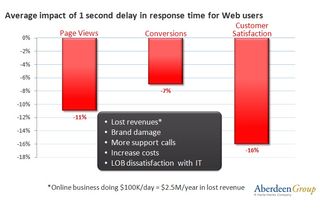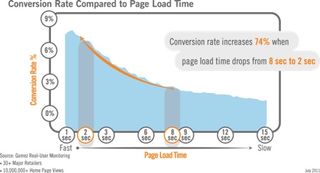Turning web traffic into sales
Much more than just revenue hinges on web site performance. Downtime, inconsistency, slowdowns and bad design can ruin customer experiences. Compuware's David Flower explains how to avoid lasting harm
Today’s best customers are multi-channel users that rely on different ways to access your business whether via the internet, mobile, or apps, to name a few. In turn businesses are focusing on ways to optimise these channels to improve conversion rates, and achieve greater results.
However, delivering an optimal customer experience is becoming ever more complex. Your consumer’s expectations are higher than ever, showing less patience for slow-performing sites. The average online shopper expects your pages to load in two seconds or less (source: Forrester Research, “eCommerce Web Site Performance Today” white paper August 2009), down from four seconds in 2006; after three seconds, up to 40 per cent will abandon your site.
Compuware Gomez’s own data underlines that lack of visitor loyalty. By analysing page abandonment data across more than 150 web sites and 150 million page views, we found that an increase in page response time from two to 10 seconds increased page abandonment rates by 30 per cent.
The causes of website problems can be complex, but the lesson is simple. So-called IT issues that slow down your site can impact revenue, customer satisfaction and your brand – if they’re not identified, monitored and resolved.
So, what do we mean by performance and why does it matter?
When we talk about web or mobile performance, we mean the technical capability of a web-based element – a web page, a mobile web page or a dedicated application – to be fully available for critical business transactions and to load at speeds that meet a customer’s expectations consistently, during peak periods, at all times of day and across all geographies.
Compare this to equivalent metrics for a brick and mortar store or a physical business location. Will your customers wait if your store doesn’t open when you say it will? Will they wait in long checkout queues (response time) to the point of frustration? What if an entire department shuts down temporarily?
The answer is a resounding “no”.
This is exactly what happens online when web and mobile site response time and availability lag behind your customer’s expectations. The correlation between page load times and sales conversions is a solid one. Make your customers wait and sales will suffer. Speed things up and you will create an opportunity to grow revenue.
Compuware recently conducted a study of the impact of performance on conversions, tallying over three million page views for 33 retailers. The results: if your page load time is eight seconds and you can improve it to two seconds, your conversion rate increases by 74 per cent.
Whether at an actual business location, or online, the quality of the customer experience is a major revenue driver. Put simply, performance is a fundamental yardstick for the customer experience online.
Your customers are impatient
Even small changes can have a big impact on your business. Let’s start with the basics – availability: how available is your site to your visitors and potential customers? According to studies by the Aberdeen Research Group, the industry average is 97.8 per cent (source: Aberdeen Group The Performance of Web Applications: Customers are Won or Lost in One Second, November 2008). Not bad, right? Wrong. Consider what a two per cent lack of availability really looks like – it means your site is out of business eight days a year. For an ecommerce generating £100,000 a day, that translates into a loss of £800,000 in yearly revenue.

How to avoid driving customers away
The best web businesses know that response time and site availability has a demonstrable effect on business results. These businesses monitor performance from the perspective of their end-users with a goal of finding and resolving problems before their customers do. There are a number of actions top-performing online organisations regularly undertake:
- Quantify the business impact of web performance. Aberdeen’s research shows that 49 per cent of the best-in-class enterprises have a real-time view into performance of revenue generating transactions, compared to 19 per cent of the average companies and 15 per cent of the laggards.
- Resolve business problems before customers find them. According to a study by Aberdeen Group, users of web performance monitoring and analysis were 50 per cent more likely to improve response times and 42 per cent more likely to reduce mean time to repair than enterprises that did not use such a service.
- Measure the quality of the real end-user experience. The ability to see the customer’s genuine experience – by key segments, and across browsers, devices and even regions – is crucial for success. 66 per cent of best in class operators have the ability to measure the quality of end-user experience, as opposed to 51 per cent and 14 per cent for average and laggard operators, respectively.
- Benchmark the competition. You cannot understand your site out of context. Companies can now leverage industry benchmarks to understand how the web experiences they’re delivering compares to competitors and respective industry norms.

Performance is a team sport
The growing complexity of the web, the explosive growth of mobile devices and the speed-obsessed end-user will force business and IT to constantly adjust to stay ahead of the curve. The good news is that a template for performance excellence has already been established and the ‘A’ players in your industry already using it. What about you?
Get the Creative Bloq Newsletter
Daily design news, reviews, how-tos and more, as picked by the editors.

Thank you for reading 5 articles this month* Join now for unlimited access
Enjoy your first month for just £1 / $1 / €1
*Read 5 free articles per month without a subscription

Join now for unlimited access
Try first month for just £1 / $1 / €1
The Creative Bloq team is made up of a group of design fans, and has changed and evolved since Creative Bloq began back in 2012. The current website team consists of eight full-time members of staff: Editor Georgia Coggan, Deputy Editor Rosie Hilder, Ecommerce Editor Beren Neale, Senior News Editor Daniel Piper, Editor, Digital Art and 3D Ian Dean, Tech Reviews Editor Erlingur Einarsson, Ecommerce Writer Beth Nicholls and Staff Writer Natalie Fear, as well as a roster of freelancers from around the world. The ImagineFX magazine team also pitch in, ensuring that content from leading digital art publication ImagineFX is represented on Creative Bloq.
